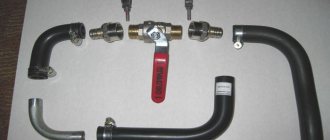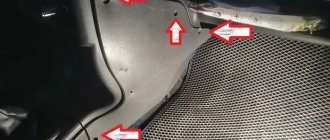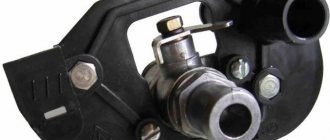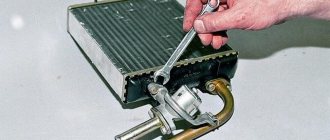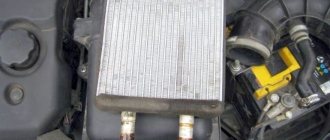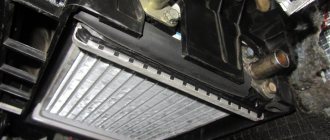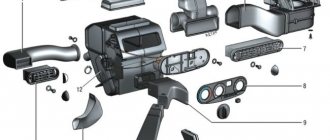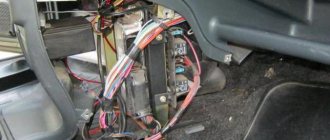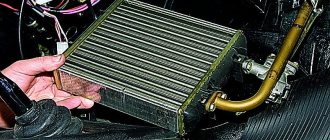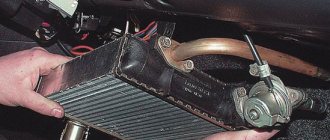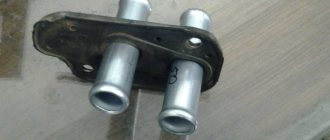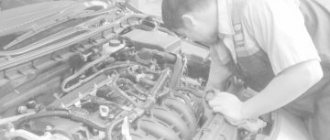Dear friends, today we will tell you how to independently remove and install the electric motor of the stove fan on the Niva VAZ-21213 and VAZ-21214. The procedure is quite simple; we only need two screwdrivers, a Phillips screwdriver and a flathead screwdriver with a thin blade. The reason for removing and replacing the heater motor may be its squealing due to wear on the bushings. Often even new heater motors suffer from this problem, so when replacing the heater motor, we recommend that you install a bearing motor. To get to the motor we need to remove the lower part of the stove body, and to get to it we need to remove the shelf, the radio panel and the decor on the tunnel.
In general, let's get started, and start by removing the storage shelf under the glove compartment, pick up a Phillips screwdriver and unscrew the following screws:
We move the shelf to the side. Then we move on to the decorative trim on the tunnel, it is also held in place by screws, they are located in this way, see the photo below:
Carefully remove the chips from the cigarette lighter, put the tunnel decor aside, we don’t need it for now. Now let's move on to the tape recorder panel. To begin, use a flat screwdriver to pry up the buttons one by one:
Carefully remove the terminals from them and move all the buttons to the side. We recommend labeling the terminals, this will speed up the assembly process and help avoid mistakes!
Gently pull the plastic nozzles of the stove levers towards you, they will come out with force:
Now again we take the Phillips screwdriver in our hands and unscrew the fastenings of the radio panel to the dashboard on both sides:
Then use a flat screwdriver to pry the panel from above and carefully remove
Now we have access to the stove body. But first, we unscrew the rotation relay to remove the minus chip of the heater fan from it:
Now we are interested in the metal latches of the stove, here they are in the photo, there are only 4 of them, two on each side:
They can be removed either by hand or by prying them with a screwdriver. Be careful, they are springy and can fly away in an unknown direction, to the land of lost things
After this, the lower part of the stove body falls into our hands and is calmly removed, we gain access to the culprit of the action - the stove motor:
It is also held on by two metal latches; it is more convenient to pry them off with a screwdriver:
After this, disconnect the motor wiring and remove it from the stove body
We remind you that the stove motor is essentially unrepairable and if it “squealed” then the bushings are damaged and then only a replacement is needed. Ideally, straight to the bearing. When assembling and installing, do not forget to put rubber spacers on the motor, otherwise vibration will occur. We perform assembly in reverse order. So you have learned how to independently remove and install the heater motor on the Niva VAZ-21213 and VAZ-21214. Good luck to everyone on the roads and fewer breakdowns.
Modernization of the Niva stove
Before installing the fan, I asked myself some questions, some were answered by this site and many others. The rest was figured out during repairs and visits to auto stores of different models. To upgrade the air intake, you will need all the remaining material that you cut, so don’t throw away the plastic and use a ruler and caliper before work.
What was and what has become.
The partition crashed from part photo number 1
Shown here is the location of the drainage system in case of rain.
Sealing rubber from VAZ 2104
Inside, before foaming, I sealed the edges with foil tape (does not corrode).
Let's start installing the fan control resistor at four speeds. We make a hole in the bottom cover (so that the resistor fits and does not touch the fan)
We make a lid from plastic leftovers to cover the resistance.
Cut a hole for the resistor itself (resistance)
And the final photos.
Installing the engine from the VAZ 08 stove on the Niva VAZ 21213
Removal of the interior heater radiator and its activation valve on a VAZ 2121 and Niva 2131 is carried out to replace it if its seal is broken, that is, for subsequent repairs or complete replacement with a new one, as well as to replace the valve. To carry out repair work, prepare a standard set of tools and perform the following sequence of actions:
- Drain the cooling system with the heater radiator valve open.
- Next, remove the hoses from the heater pipes and the seal.
- We remove the heater fan.
- We take out the radiator with the tap, and then use a ten key to unscrew the two bolts securing the tap itself.
- We remove the tap.
- Next, remove the nuts of the tank mounting bolts from the grooves of the tank.
- On the opposite side, unscrew the two bolts and remove the outlet pipe along with the rubber sealing gasket.
- Carry out the necessary replacement, then assemble and install in the reverse order.
At this point, the repair work to remove the heater radiator, its tap and pipe on the VAZ 2121 and Niva 2131 cars has been completed.
Sources
- https://www.vazdriver.ru/snyatie_i_zamena_i_ustanovka_ventilyatora_pechki_na_nive_vaz21213_i_vaz21214.html
- https://spike.su/index.php/Pechka-NIVA.html
- https://remont-vaz2106.ru/kak-snyat-radiator-otopitelya-s-kranom-vaz-2121-niva-2131
Typical radiator malfunctions
There are two main radiator malfunctions:
- Clogged grille and radiator tubes.
- Radiator leakage.
Since the Niva is often operated in difficult road conditions, the likelihood of contamination of the grille from dusty outside air is very high. Clogging of the cells reduces the heat transfer area of the radiator, and as a result leads to a decrease in the heat released from the air ducts into the passenger compartment. In such cases, the stove radiator is dismantled and washed under high pressure.
Clogged radiator tubes are also common. If the outlet pipe is barely warm or cold, then the radiator tubes are clogged. This happens for various reasons, including the entry of foreign objects into the cooling line during repair work. In such cases, the tubes themselves are also washed. To do this, it is not necessary to remove the heater radiator. It is enough to separate the radiator pipes from the cooling system and supply water under pressure into one of the radiator pipes.
A leak in the radiator tubes can be determined by a coolant leak, which usually forms on the right side of the center console in the passenger foot area. As a rule, a leak is accompanied by the smell of antifreeze (antifreeze) in the cabin. Don't rely on the smell of antifreeze alone. Coolant vapor is very volatile and can be misleading as to the source of the leak. The smell of antifreeze also indicates a leak in the engine compartment.
The leakage of the heater radiator occurs due to natural wear and tear of the metal from which it is made. Constant cycles of heating and cooling, exposure to various chemicals and consumable liquids eventually lead to the destruction of the metal and the formation of cracks. Cracks in a copper radiator can be soldered. The aluminum radiator will have to be replaced with a new one.
Typical malfunctions of the VAZ-2121 heater radiator can be eliminated in a garage environment
Improvement No. 1. We take air from the cabin
The main disadvantage of the Niva heater is that all the air into the heater radiator comes from the street, and when the air intake flap is closed, air circulation and heating stop completely. To eliminate this drawback, I disassembled the heater (I had to drain some of the antifreeze and disconnect the heater radiator pipes), and in the side wall of the heater housing, opposite the wall where the radiator tubes exit, I made a hole in the shape of a rectangular trapezoid. I did it in such a way that there was 1.5-2 mm of the body wall left to the boundaries of the plane in which I made the hole, and 6-8 mm from the side of the stiffener for attaching the petal valve. I made the hole using a drill, marked it, drilled along the contour of the small diameter holes, then connected the holes using a knife, then filed the edges of the resulting hole, giving it its final shape. The area of the resulting hole was approximately 25 square centimeters. It is through this hole, when the heater air intake flap is closed, that air is drawn from the passenger compartment.
Instructions for replacing the stove
Replacing the radiator of the Niva stove is carried out as follows:
- First, you should drain all the coolant from the heating unit and cylinder block; to do this, place a container under the drain hole and unscrew the cap. If you are sure that the entire system is sealed, then there is no need to drain the consumables, just turn off the tap.
- The next step will be to remove the center console and the shelf under the glove box. For greater convenience, you can also remove the gearbox lever, since it will get in the way.
- After completing these steps, you can remove the lower air duct. It is not necessary to remove it, but doing so will make your repair much easier.
- Next, you need to unscrew the bolts that secure the radiator assembly bracket.
- After the bolts are unscrewed, it is also necessary to loosen or completely unscrew the screws securing the front panel on the left and right sides. It is not necessary to completely dismantle the panel.
- Then you can remove the rods from the faucet of the heating unit, after which you can remove the casing with the fan.
- At the final stage, the radiator device is removed, but before that you need to disconnect and dismantle the pipes. Be careful, some coolant may remain in them. The new radiator assembly is mounted in place of the old one, further assembly is carried out in the reverse order, making sure that there are no air pockets in the system. Otherwise, the efficiency of the stove will be minimal.
1. Disassemble the center console and remove the gearshift lever.
2. Disconnect the rods from the heater valve and remove the casing.
3. Remove the old radiator and install a new one in its place.
How to replace a tap on a VAZ 2101-2107 “classic”, “Volga”, “Niva”, “Oka” (work order)
The operations for replacing the heater valve on different cars are very similar and differ mainly in the need to dismantle some parts to gain access to the failed valve.
Note: the heater faucet from the Zhiguli also fits the Volga, Niva, and Oka cars.
Next, we will consider in detail the replacement of the tap on VAZ 2101-07 “classic” cars.
According to the instructions, before proceeding with the removal of the pipes, it is necessary to drain the liquid from the engine cooling system. This operation can be omitted, given the fact that the stove radiator and pipes are located above the level of the main radiator. It follows from Honor that some of the coolant will still leak out, so you need to have a small container on hand.
Use a screwdriver to loosen the clamps and remove the hoses from the heater radiator pipes. Do not forget to place a container under the hoses to drain the coolant leaking from the pipes.
Using a key “8”, unscrew the two screws and remove the seal from the radiator pipes.
In the car interior, remove the instrument panel shelf. For convenience, remove the glove box body. On VAZ 2104, 2107 with an instrument panel with side air ducts, it is also necessary to dismantle the air duct by unscrewing the nut to “10” and prying the latches around the perimeter with a slotted screwdriver.
Using a key set to “7”, loosen the screw and disconnect the heater tap drive rod (1).
Using a “10” wrench, unscrew the two nuts securing the valve to the heater radiator (2) and remove the heater valve along with the inlet pipe and rubber gasket.
Using a “10” wrench, unscrew the two nuts and disconnect the inlet pipe with the gasket from the tap. Pay attention to the gasket profile.
We remove and replace the drive rod mounting bracket on the new faucet.
Advice: it is better to replace “old” metal hose clamps with new reinforced ones (blue).
We install a new faucet with new gaskets in the reverse order of removal. To be on the safe side, we apply sealant to the joint surface between the faucet and the radiator, as well as the faucet and the inlet pipe.
We fill the engine cooling system with liquid (if it is completely drained) or add some of the liquid that leaked from the pipes and radiator during replacement, and make sure that the connection between the valve and the heater radiator and the inlet pipe is tight.
Fan replacement
Experienced car owners recommend not stopping there and continuing to modify the stove by tuning the fan.
Some people suggest getting rid of the fan installed by the manufacturer and installing a figure eight fan instead.
If you also decide to carry out such a replacement, you need to additionally decide whether you will leave the original control of the stove or also replace it with a “eight” analogue.
Having decided on the second option, take care of purchasing the following additional items:
- fan speed switch;
- additional resistor for the stove.
So, after you have completely prepared all the necessary components, you can proceed directly to the process of modifying the fan.
Initially, you should dismantle the old air supply box. Unfortunately, despite the fact that this requires unscrewing only four nuts, it will not be possible to do this without outside help. Your partner will need to hold the screws under the hood while you unscrew them using a wrench.
After this, you can easily remove the air intake. Clean it if it needs it, and then cut away a small amount of the plastic to provide enough space for the new fan to operate.
Install the fan and carefully inspect for anything that may interfere with the operation of the installed fan. If you find such obstacles, carefully cut them off.
Once you are sure that there is nothing else that can prevent the fan from working, secure it with sealant. There are small gaps around the fan nozzle; it is important to eliminate them by covering them with any material. This will prevent warm air from escaping.
Now the assembled fan is being introduced back into the space in which its old counterpart previously “lived”. Everything is securely fastened and the closing and opening of the hood is checked. In some cases, after the introduction of a “foreign” fan, it is not possible to close the hood normally.
If everything is fine, reconnect all wires and install new controls. Upon completion of the work, be sure to check your results in action.
The stove should work perfectly, and warm air should spread very quickly inside the car.
How to change a faulty stove on a Niva Chevrolet
There are no unnecessary parts, devices or mechanisms in the vehicle. Each of them is of no small importance in ensuring the successful movement of the car. However, if you wish, you can still classify devices and mechanisms into those that you cannot do without even for a short time, since the safety of the driver and passengers depends on them. In particular, in winter it is unlikely that there will be a driver who will agree to drive a car with icy windows.
If the vehicle is in good technical condition, icy windows will not become an obstacle to the trip; all you need to do is turn on the heater, direct a stream of warm air onto the windows, wait a few minutes and make sure that there are no more obstacles. Unfortunately, if the Chevrolet Niva stove fails, there is no way to remove the ice. Even if you use additional tools and clear the snow with special scrapers, traveling in such a car is dangerous, since the snow will settle again throughout the entire journey, making it impossible for the driver to sufficiently monitor the road. For this reason, car owners decide to replace the stove on a Chevrolet Niva with an installed air conditioner.
Dismantling
So, if you need to figure out how to change a failed stove on a Niva Chevrolet, we are ready to share the relevant information with you. First of all, we draw your attention to the fact that dismantling such a device is not carried out for the sake of idle curiosity, so you must make sure that your heating system really needs repair work.
If you are convinced in practice that the heating of your car is not able to function efficiently, then you need to take consistent steps. Initially, for safety reasons, you need to turn off the power to the device being dismantled. To do this, simply disconnect the negative terminal from the vehicle battery.
Don't forget to prepare the tools you will need for subsequent work. We suggest you remove the instrument panel. On the heater control panel there are switches with which you regulate the direction of the air flow, as well as its speed. Grasp these handles and pull them towards you, they will give way and you can remove them all one by one. After this you will reach the decorative control panel. It will be easy to remove if you use a screwdriver and unscrew all the bolts. The control panel will now be easy for you to remove, but only for a short distance, since it is still held in place by the wires and rods of the damper drive. All of them must also be disconnected. If the heater cable breaks, you will need to repair it by using glue or twisting steel wire around it. You can, of course, purchase a new cable if the financial costs do not bother you. Now you need to disconnect the fan switch, also after unscrewing a few bolts that secure it to the panel.
Replacing the heater tap
The standard heater tap on Niva 21213 does not do its job. Since it has a small cross-section, coolant flows quite slowly through the radiator. In addition, it often becomes a place for coolant to leak into the cabin. Therefore, car owners prefer to exchange it for similar models from other AvtoVAZ, Volkswagen, Toyota or Opel cars. For example, the ceramic faucet installed in 2108 has a large diameter passage opening, which increases the performance of the stove. It is better to install it in the pipe that supplies coolant to the stove, otherwise even if it is closed in the warm season, heated air will still flow into the cabin.
Removing the radiator of the VAZ-2121 stove
The procedure for removing the heater radiator on a VAZ Niva does not require any special skills or abilities. It is important to prepare the necessary materials and tools in advance. Most instructions for repairing car heaters contain a recommendation to drain the coolant before starting work. In practice, many car enthusiasts limit themselves to draining only that part of the antifreeze that is located in the radiator itself and the nearby pipes of the cooling system.
Preparing tools
To replace the radiator, you will need the following tools:
- pliers;
- slotted screwdriver;
- Phillips screwdriver;
- a set of markers for identifying wires;
- spanner set to “7”;
- socket wrench set to “10”;
- socket wrench set to “7”;
- socket wrench set to "10".
Procedure for dismantling the radiator
All operations must be performed in the following sequence:
- Unscrew the left self-tapping screw securing the storage shelf.
The self-tapping screw is unscrewed with a Phillips screwdriver - Unscrew the two self-tapping screws on the right shelf fastening.
The right side of the shelf is attached to the upholstery - Unscrew the central fastener of the shelf from the front panel.
The central part of the shelf is unscrewed from the front panel - Carefully lower the right side of the shelf.
The right edge of the shelf moves down freely - Remove the left side of the shelf from the center console panel.
There is a special spike on the left side of the shelf - Unscrew the self-tapping screw securing the floor tunnel lining to the radio mounting panel.
The lower part of the panel is also fixed with a self-tapping screw - Unscrew the screws of the left and right fastenings of the central panel.
The process is shown on the right side, the left side is similar - Remove the radio panel.
The panel is moved to the side - Disconnect the wire connectors from the radio panel.
The wire blocks are detached to remove the entire radio panel - Completely dismantle the panel.
After disconnecting the wires, the panel can be easily removed - In the engine compartment, loosen the clamps securing the hoses to the radiator pipes.
Loosening the clamp is shown using the example of the lower pipe; a similar operation is performed with the upper - Unscrew the screws securing the seal from the front panel.
The screws are unscrewed with a socket wrench with a “7” head - Remove the seal.
The removed seal allows you to remove the radiator pipes from the engine compartment - In the cabin, loosen the nut securing the crane drive rod.
The fastening nut is unscrewed with a “7” key - Remove the heater valve drive rod.
The rod is removed from the crane lever - On the right side of the fan casing, remove the heater tap rod from under the bracket.
The rod is disconnected from the fan casing - Disconnect the spring brackets securing the casing.
The staples are pryed off with a slotted screwdriver - Remove the casing and fan.
The casing with the fan is moved to the side - Remove the radiator.
After removing the fan, the radiator is carefully removed from its compartment - Unscrew the faucet from the radiator.
The tap and pipes are turned off with a key to “10” - Remove the heater valve.
The removed tap is checked for leaks - Remove the lower nut securing the faucet to the radiator.
The bottom nut often falls out and gets lost - Disconnect the outgoing pipe.
The two fastening nuts are unscrewed with a “10” wrench
After dismantling, you should carefully inspect the radiator for blockages in the grille and leaks from the tubes. Based on the results of the inspection, a decision is made on the possibility of repair or installation of a new radiator.
Video: installing a radiator
The process of replacing the heater radiator on a classic Niva has been studied far and wide by many car owners. In fact, the procedure is similar to the entire family of AvtoVAZ classics. However, caution and safety precautions should be observed when working. After completing the repair, before driving on public roads, you must make sure that all components and mechanisms of the vehicle are operating normally. Only then should you begin daily use of the machine.
- Author: Andrey Lysenko
Rate this article:
- 5
- 4
- 3
- 2
- 1
(11 votes, average: 4.4 out of 5)
Share with your friends!
Related posts:
Do-it-yourself repair and replacement of the Niva Chevrolet car heater
Diagnosis of faults, repair and replacement of elements of the VAZ 2113-15 stove with your own hands
Diagnosis of faults, repair and replacement of the Chevrolet Lanos heater radiator with your own hands
DIY tuning of Niva 2121 for off-road
Like many parts in the Chevrolet Niva, we change it ourselves, the radiator is no exception.
Points by which you can diagnose a breakdown of the Chevrolet Niva heater radiator:
- the amount of antifreeze in the tank has sharply decreased;
- reduction in the quality of heating of the car interior;
- the appearance of a thick, greasy film on the inside of the glass;
- there was a clear smell of antifreeze in the car;
- accumulation of antifreeze under the driver's mat.
Having discovered any of them, you need to diagnose the Chevrolet Niva heater radiator in order to determine the next steps for repair or replacement.
Before replacing a spare part, the system is completely emptied of coolant. Replacing a Chevrolet Niva heater radiator without air conditioning will not cause any difficulties and does not require special skills. You can carry out the work of replacing a Chevrolet Niva heater radiator even on a simple overpass.
If you cannot adjust the position of the regulator, the cable may have broken. For replacement, a typical set of wrenches or ratchets and a flashlight will suffice. It is most convenient to use a headlamp; this will allow you to repair the stove without difficulty.
Sequencing:
The driver's seat moves back as far as possible. Unscrew the bolts and handles located on the control panel. The panel is dismantled from the driver's side, i.e. at the bottom left. The latches that secure the cables are disconnected. To remove the cable, the fan damper is dismantled. When installing a new cable, pay attention to the fact that its ends on both sides must be twisted into a ring and securely fastened.
Assembly is carried out in reverse order
At the end of the work, it is important to make sure that the cable is working properly by checking
A little lower you will find a bracket holding the shell of the damper drive rod. You need to carefully pry it off with a screwdriver. Do the same with the other rods, ensuring that the control unit is completely disconnected.
You also have to disassemble the control unit when you discover that the heater of your Chevrolet Niva does not work or works with serious problems.
Very often the electronic control unit for the stove installed on your Niva fails. In this case, you will still have to turn to qualified electricians for help, since you can remove the unit, but you cannot identify the cause of the problem. To carry out such work, it is very important to have various tools, instruments, testers and devices, and it is also important to have good knowledge of electrical engineering.
So, if you are unhappy with the way the stove works on your Chevrolet Niva, you don’t like the fact that the car’s interior warms up slowly, then act boldly, look for the reasons, solve problems, armed with tips and necessary instructions, and enjoy the good performance of your car.
Possible heater malfunctions and ways to eliminate them
Cherry Niva Chevrolet
If the stove in a VAZ 21214 has stopped working, then, in principle, repairing it yourself is not a particularly difficult task.
The reasons for the malfunction why the Niva stove refuses to work are given below:
- Failure of the additional resistor. This element of the system is located behind the glove box and is designed to control the ventilating device for pumping warm air into the cabin. The problem is solved by replacement.
- Wear of pipes. Over time, the pipes begin to wear out, and temperature changes especially contribute to this. To detect worn hoses, each line must be carefully inspected. Wear may be indicated by cracks and other damage to the pipes through which antifreeze can escape.
- The heater valve is faulty. A breakdown of this component may be indicated by traces of a coolant leak in the vehicle interior. If the heater tap is being replaced, it is better to use a ceramic device; its service life is usually several times higher than that of traditional metal devices.
- Problems in the operation of the control unit. It is best to have this part repaired by a qualified electrician.
- The heater radiator has failed. On Niva 21213 you can easily replace it with your own hands, we will talk about this below (the author of the video is the OWNER G channel).
It is very easy to find a broken fan resistor - the fan only runs at maximum speed.
The radiator is leaking: what to do, how to find the leak and how to fix it
The cooling radiator is the main element of the engine cooling system.
The operation of a cooling radiator is the active transfer of heat into the atmosphere from the heated coolant. This process is important for efficient engine operation, because The coolant, before giving off heat in the radiator, takes this heat from the heated components and parts of the engine. This was originally intended by the designers, but life makes its own adjustments to the operation of the car on the road. A situation when the arrow on the dashboard begins to treacherously creep up, and, unfortunately, this arrow is not an indicator of the fuel level, but an indicator of the coolant temperature, modestly indicating that the car is starting to overheat. Steam is pouring out from under the hood, and a liquid stain of coolant is slowly but surely spreading on the asphalt. The radiator is leaking, what should I do?
Causes of radiator leaks in the car cooling system
Before you do anything, you need to figure out what led to this result. This may be external damage as a result of stones, or the plastic elements of the radiator may crack as a result of an impact in a minor accident. Such minor damage, as a rule, cannot be immediately identified, and problems arise from them over time. In the meantime, the driver continues to operate the car, gradually, drop by drop, losing coolant from the system.
What is the danger of antifreeze leaking from a car cooling system?
As the coolant level drops, the risk of engine overheating increases, which in turn can lead to the following problems:
Deformation of the plane of the cylinder block or cylinder head
Cylinder head gasket deformation
· Changes in the configuration of the cooling system and associated failure of system components
All of the above cases will lead to expensive repairs.
What to do if the cooling radiator is leaking
The first rule in this case is to monitor the coolant level.
In fact, periodically checking the vehicle's technical fluids before a trip is a good rule; this will help to promptly notice an emerging problem and eliminate it. Even if the cooling radiator leak is small, do not underestimate the scale of the current situation. Over time, radiator leakage will increase, and this point can be overlooked. The driver will not like the result.
Therefore, if such a situation occurs, it is necessary to have a supply of coolant or distilled water. Yes, if the loss of coolant is small, then for the first time you can use distilled water, but you need to take into account that the more distilled water gets into the system, the more we increase the freezing point of the coolant. Therefore, if it’s winter outside, you shouldn’t get carried away with distilled water, but add coolant.
What to do in case of major damage and leakage of the cooling system
If there is serious damage to the engine cooling system, repairs are inevitable; operating the vehicle in this case is extremely undesirable. And in order not to end up with engine repairs, you should move the car to a technical center using a tow truck, or, in extreme cases, on a cable.
How to seal plastic parts of a cooling system with a leak
If the design of the radiator allows, then you can use a heat-resistant sealant-adhesive, better known as cold welding. In some cases, you will need to remove the radiator from the car.
Cold welding is a special two-component sealant that may contain metal shavings. Such sealants allow you to quickly restore plastic or metal parts.
The gluing process itself is not complicated:
· Before applying the sealant, the surface must be prepared, cleaned and degreased.
· Prepare the sealant for use by mixing the two components. The components must be thoroughly mixed to obtain a homogeneous mass.
· The sealant is applied to the part.
The composition will set in 3-5 minutes, but until complete hardening it will take from an hour to a day, depending on the composition.
Is it possible to solder aluminum radiators and how to do it correctly
If a radiator leak occurs on an aluminum part, then sealing is possible.
The process is complicated, and we would recommend entrusting it to professionals, because... If the attempt fails, you will have to redo everything again. · You will need a powerful soldering iron and it must be warmed up well before work.
· The walls of the radiator will also need to be thoroughly heated.
· Clean the surface thoroughly before soldering.
· To ensure good soldering quality, it is necessary to use solder with a high tin content.
This method will require removing the radiator from the car, which means that when installing the radiator back after repair, it is advisable to completely replace the coolant.
Repairing antifreeze leaks in the cooling system using a special sealant
There is another way to eliminate a radiator leak that does not require partial or complete disassembly of the system. This is a sealant that works inside the cooling system. For example, Liqui Moly - Kuhler-Dichter cooling system sealant. This product seals small leaks in the radiator, metal porosity in solder areas, and hairline cracks. Seals damage that is quite difficult to localize (determined only by a drop in the coolant level). You can use the product with all types of additives in the cooling system and any antifreeze. Suitable for all cooling and heating systems.
Contains water-soluble monomer and plastic chips suspended in a monoethylene glycol solution. When there is a pressure difference and when oxygen is available, the polymerization reaction is activated and the polymerization products seal the coolant leaks.
Application of the sealant is very simple:
· Shake the can before use.
· Add sealant to the cooling system at the rate of 250 ml. additives for 10 l. coolant.
· Let the engine idle or drive the vehicle for at least 10 minutes.
The sealant can remain in the cooling system for the entire service life of the coolant.
To avoid major repairs, you should regularly check the cooling system for the slightest malfunctions and leaks, change hoses and pipes in a timely manner, and monitor the temperature of the antifreeze during operation. Also, do not forget to change the coolant in a timely manner, as over time it loses its properties, which can lead to malfunctions in the operation of the entire system.
Air duct modernization
Unfortunately, if you carefully examine the air ducts that your Niva is equipped with, you will be horrified at how it was possible to install so many cracks in it. Is it possible to expect good heating with such a design?
The answer, of course, is simple, since all the heated air is dispersed under the dashboard, and the interior is heated according to the residual principle.
However, it’s good when a problem is so easily identified, then solving it is much easier. Upgrading the air duct involves applying silicone glue to all joints.
Be prepared for the fact that performing such actions is sometimes quite difficult, since not all places have unobstructed access. You still have to get used to it and apply silicone glue to all the joints.
Application area
- Polypropylene pipes: technical characteristics and simple installation allow these pipes to be used in water supply systems as a distribution mechanism in administrative, industrial, and residential buildings for process and drinking water pipelines.
- The technical characteristics of polypropylene pipes make it possible to use them in the agricultural sector.
- Polypropylene fittings and pipes of 3 types are intended:
Polypropylene pipes and fittings
Other details
The standard heater radiator and thermostat are also replaced. Preference is given to three-row copper radiators. They are more efficient in operation and leak less often. The thermostat is replaced with an analogue one or its thermal insert is modified.
Do-it-yourself modification of the stove on Niva 21213 with your own hands is quite labor-intensive and takes a lot of time. To modify the heating system of this car, you can find ready-made kits on sale that make this work easier. The procedure is presented in the video “Remaking the stove on Niva 21213 with your own hands: video instructions.”
